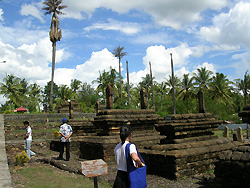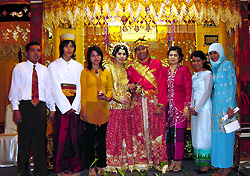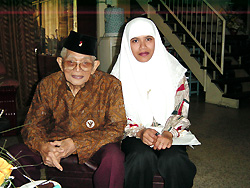| Period: 22 December 2004 - 8 March 2005. Country: Indonesia |
|
(1) The “Shape” of South Sulawesi: An Anthropological Study of the La Galigo Epic |
| KUSUDA Kenta (Division of Southeast Asian Area Studies) |
| Key Words: La Galigo, Bugis, Makassar, South Sulawesi, Mythology |
 |
| Tombs of the Buginese Kings in Bone Prefecture, South Sulawesi. |
 |
| A Buginese style wedding ceremony in Makassar ―incredibly flashy! |
 |
| Andi Mattalatta (left) is a direct descendant of the Buginese royalty as well as a political dignitary of South Sulawesi. It is impossible to tell the 20th century history of South Sulawesi without him (he is pictured at his residence in Makassar). *[He passed away in October 2004 at the age of 84.〕 |
(2) La Galigo is a mythical epic that is widely known throughout South Sulawesi, Indonesia. The epic begins from the son of the heavenly god, Batara Guru, and the daughter of the underworld god, We Nyli’timo, and follows the line of the family they found until their 6th generation descendants. The leading characters of the story are the 3rd generation descendant, Sawerigading, and the 4th, I La Galigo. My main interests are the three following points.
- Placing La Galigo in the historical context of modern South Sulawesian society
The story of La Galigo takes place in the era before the 13th century, which is to say, before Islamization. Therefore, the epic is an indispensable source for understanding the traditional moral code and social structure of the Buginese and Makassarese, who form the majority populations in this area. South Sulawesi is in the periphery at the national level, and now La Galigo can take on a renewed meaning as an ethnic code, especially with the promotion of decentralization in the post-Suharto regime. I am focusing on how the myth has been incorporated into the efforts to transform the local society, and how it has been reinterpreted.
- Evaluating La Galigo as a literary work.
La Galigo is known for its high quality as a literary work, and is sometimes even described as one of the best works of literature in the world. Therefore, a comparative literary approach is effective. I will make a comparison between La Galigo as a text and other myths in other regions, and novels, etc.
- Introducing La Galigo to Japan
La Galigo is not well known in Japan. The reasons are that it is written in local languages, such as Buginese and Makassarese, which are not familiar to most Japanese, that a standard version never existed because originally it was transmitted orally, and that the manuscript (called Lontaraq) which amounts to over 300,000 lines, is spread out across South Sulawesi. That is why long-term fieldwork is required for this work. In any case, I am certain that introducing this creation to Japan will have tremendous significance as a fruit of area studies through translation and publication.
In a broad perspective, the research will be carried out in the order of 3→2→1.
(3) Among the various local languages spoken in South Sulawesi, on this trip I focused on and learned Buginese. The text I used was for elementary school children, and my teacher was a friend who is a native speaker of Buginese. In addition, I widely collected documents about La Galigo and South Sulawesi, and I visited historic sites related to La Galigo.
Additionally, I was very fortunate to meet Mr. Muhammad Nur. Although he belongs to neither a university nor research institute, he is a prominent academic who has already published some books on the history of South Sulawesi. At present he is engaged in compiling vast genealogical trees of the Buginese royalty (called Silsilah). He has pursued this theme for 10 years, but has not finished the work yet. The compilation has already passed 300 pages. This achievement, which he has done alone, will no doubt be a crucial document for the study of South Sulawesi.
In Japan, I have continued to learn Buginese and started to translate I La Galigo (R.A. Kern: 1989: Gajah Mada University Press), which is a must-read book for the study of La Galigo. The work will be continuously uploaded onto the web as it progresses.
|



 21st Century COE Program
-Aiming for COE of Integrated Area Studies-
21st Century COE Program
-Aiming for COE of Integrated Area Studies-